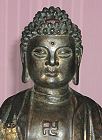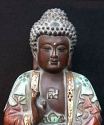
The Swastika in Asian ArtAlthough the Swastika is often synonymous with the Nazi movement of the 20th century (actually a reverse swastika), it was widely used in ancient times as a symbol of prosperity and good fortune. It originally represented the revolving sun, fire, or life. One of the oldest known Swastikas was painted on a paleolithic cave at least 10,000 years ago. The Swastika was widely utilized in ancient Mesopotamia coinage and appeared in early Christian and Byzantium art. In China, about 2000 years ago, when Buddhism was brought to China from India, the Chinese also borrowed the Swastika and its sense of auspiciousness. In China, the Swastika is considered to be a Chinese character with the reading of WAN in Mandarin Chinese. In North America, the Swastika was a symbol used by the Navajos. The Swastika still continues today to be an extensively used sign in Buddhism, Jainism and Hinduism. The Swastika is often tattooed on monks in Tibet. The Dalai Lama's throne is always decorated with four Swastikas. In India people mark their cows, fields, homes, shrines with the Swastika, a sign of good luck and fertility to symbolize night, magic, purity, and the destructive goddess Kali. In Buddhism, a Swastika represents resignation. It is usually found in the images of Buddha on his chest, palms, soles of feet. It is called the WAN symbol in Chinese and MAN in Japanese. The word Swastika is derived from the Sanskrit and means, "conducive to well- being". S-vasti in Sanskrit is translated as, "It is well". The Swastika represents the Heart of the Buddha Shakyamuni, resignation of spirit, all happiness that humanity desires, mind, infinity, all, many, 10,000.
The right hand (clockwise) Swastika is used by these religions which practice ahimsa (non-violence) since ancient times. It should never be confused with the left-hand (counterclockwise) Swastika adopted by Adolf Hitler for his Nazi movement. Closeups of the statues on this page and every sculpture in the Villa Del Prado Light of Asia Collection can be found on the main page. |
 The symbol is commonly found on Chinese bronze Buddha statues and sometimes on stone, ceramic and wood sculptures. It is much less common in other types of renderings.
The symbol is commonly found on Chinese bronze Buddha statues and sometimes on stone, ceramic and wood sculptures. It is much less common in other types of renderings.
